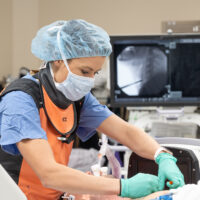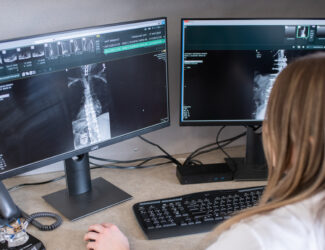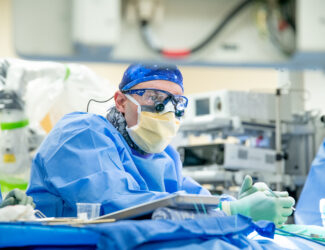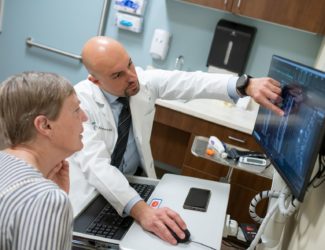If you’re considering spinal fusion to treat back pain, you’ve probably already read up on the benefits of the procedure. But you also will want to know the common problems after spinal fusion and the likelihood that you will experience these.
At Neurosurgery One, we are very careful to only recommend spinal fusion for patients who have conditions that have been medically proven to benefit from surgery. Prior to surgery, we will assess your bone health to ensure that the fusion has strong scaffolding. If your bones are weak, we have a specialized program to help build bone strength before surgery. Increasing bone strength will help with your immediate and long-term results and help prevent other problems, such as adjacent parts of your spine deteriorating.
You also will be asked to attend a spine surgery class that will teach you how to get better outcomes and avoid common problems after spinal fusion. You’ll learn, for example, how you can improve healing after surgery by what you eat and how to prepare your home for spinal fusion recovery.
Complications following spinal fusion surgery are unlikely, but they can occur. Knowing what to expect will help make you more comfortable with your recovery and help you know when there is a problem you should alert your team about.
Speaking of teams, it’s good to understand who is on your surgery team. Neurosurgery One spine surgery teams include a spine neurosurgeon, physician assistants and certified nurse practitioners. By having a comprehensive team, we can ensure that you get thorough care before and after your surgery. You will have a lot of interaction with our nurse practitioners, like myself, who are specially trained in spine surgery. Our role — in addition to assisting during surgery — is to be your main point of contact before and after your surgery. In addition to conducting patient evaluations and follow-up exams, one of our most important roles is to provide you with the information and support you need to obtain the best outcome after surgery as possible.
In this post, I’ll help you understand the most common problems that can occur after spinal fusion. We’ll explore their severity and likelihood, as well as the potential long-term challenges you might face. By understanding these issues, you can be better prepared for what’s ahead and get the most out of your spinal fusion.
Common Problems After Spinal Fusion
During spinal fusion, your Denver spine surgeon will apply bone graft that will cause the vertebrae to grow together into a single segment over the next several months. Rods and screws will be affixed to your spine to keep the vertebrae in place while fusion occurs. This hardware will remain indefinitely; there’s no need to remove it later on.
Here are some of the common problems after spinal fusion you may experience:
Pain and discomfort. You will most likely experience some moderate level of pain after spinal fusion due to the incision and the disruption internally that was caused when accessing your spine. At Neurosurgery One, we use a unique program called Enhanced Recovery After Surgery (ERAS) that has been proven to reduce pain and the use of opioid medication following spine surgery. This pain should lessen each day after surgery and be nearly gone by your 2-week post-op appointment.
Restrictions. Following spinal fusion, you will need to adhere to the restrictions we recommend to allow proper healing and to avoid damaging nearby spine segments. You’ll need to avoid what we call the BLTs (bending, lifting and twisting) for 4-6 weeks following surgery. During that time, you’ll be able to do things like bending over to tie your shoes , but we don’t want you lifting anything heavier than a gallon of milk or moving objects from one place to another by twisting.
Muscle stiffness and weakness. Due to this restricted movement, the muscles surrounding your spine may become stiff and weak. Don’t worry, though, as you’ll start physical therapy around the 4-6 weeks after surgery that will help restore your strength, flexibility, and range of motion. Your therapist will assess your mobility and create a rehabilitation plan tailored to your progress that will include stretching and strength-building exercises.
Fatigue. Fatigue is common following any surgery and can be particularly nagging following spinal fusion surgery. Keep in mind that your body has been through a lot and requires time to heal. Prioritize rest and sleep during the first two weeks following surgery. The severity of your fatigue should lessen over time.
Nerve irritation. Spinal fusion allows space for nerves to open back up after having been compressed for a long time. As they begin to function again, irritation can occur and cause pain, numbness, or tingling in the back, arms, or legs. This is usually temporary and resolves within a few weeks after surgery.
Possible Long Term Problems After Spinal Fusion
With spinal fusion, there are some long-term challenges and complications to consider:
Limited mobility. Losing spinal flexibility is the biggest concern I hear from patients. While fusion will restrict some natural movement, most patients say they actually gain mobility because the surgery reduces or eliminates the pain that was causing them problems in the first place. With that said, it’s good to be aware of what to expect.
When one or more spinal segments are fused, you will lose some flexibility in your spine. Usually, the loss is small — if you notice it at all. The loss of flexibility increases with the number of levels that are fused. Because most spinal fusions involve only one level (two vertebrae), the loss is typically minimal.
The impact of this loss of flexibility also depends on which levels of the spine are being fused. Patients who have cervical fusion may “feel” like they have a greater loss of motion than patients who have low back fusion since the neck generally flexes more.
How you experience loss of flexibility also depends on your overall health, how well you follow your physical therapy program, and what type of activities you want to perform.
Nerve damage. While spinal fusion aims to alleviate nerve compression and associated symptoms, some patients may continue to experience nerve pain after surgery. The severity and likelihood of these symptoms can vary. They may include numbness, tingling, or burning in the legs, back, or arms. It can take up to two years for nerve damage to resolve. Very rarely, the damage can be permanent if the nerve was compressed prior to surgery for a long time.
Adjacent segment disease. Some patients may develop problems in the vertebrae above and below the fusion. It is not clear whether this is due to extra stress being put on those sections from the fusion or whether these patients are experiencing continued degenerative disc disease that would have occurred even without the initial fusion surgery. The severity of adjacent segment disease varies among individuals. Many patients never experience pain from the degeneration while some patients will have symptoms that require treatment down the road.
Revision surgery. It’s estimated that anywhere from 8-45% of spinal fusions performed will need revision surgery. The main reasons are due to the spinal canal narrowing again due to further deterioration, incomplete fusion, implant problems or infection. As I mentioned at the beginning of this post, we take many precautions to prevent these problems. Our careful selection of patients, our bone strengthening program and attention to infection are three main reasons our revision rates are low.
Recovering from spinal fusion surgery requires patience and commitment. By understanding the severity and likelihood of the common problems after spinal fusion, you can better prepare yourself for the recovery journey. Remember, your Neurosurgery One team is here to support you every step of the way.
—
Jamie Henry MSN, APN, FNP-C, CNRN is a board-certified nurse practitioner, holistic nurse and neuroscience nurse specializing in care of neurosurgical outpatients. She sees patients at Neurosurgery One Littleton and Lone Tree. Jamie is often involved in the care of patients from initial assessment and diagnosis, through their post-operative follow up visits, and anywhere in between. She strives to ensure our patients and their families feel well-prepared before, during, and after neurosurgical procedures.
Read More About Spinal Fusion and Spine Surgery








